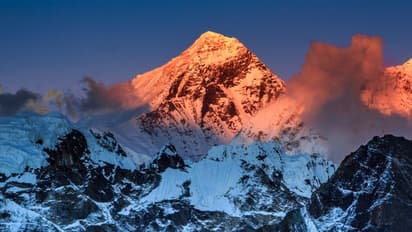Mount Everest growing TALLER! World's highest mountain has increased up to 164ft in 89,000 years; here's why

Synopsis
Researchers from University College London have uncovered that Mount Everest has experienced significant growth over the past 89,000 years, increasing in height by approximately 15 to 50 metres (49-164 ft).
At 8,849 metres (29,032 ft), Mount Everest has long been regarded as the ultimate challenge in the realm of mountaineering. However, new research suggests that climbers in the future may face an even tougher ascent, as the world's tallest mountain is continuing to grow taller.
Researchers from University College London have uncovered that Mount Everest has experienced significant growth over the past 89,000 years, increasing in height by approximately 15 to 50 metres (49-164 ft). This unexpected expansion is attributed to the erosion of material by nearby rivers, which has caused the mountain to become lighter and rise at a rate of about 2 millimetres per year.
Co-author Adam Smith noted the mountain's remarkable stature, saying, "Mount Everest is a remarkable mountain of myth and legend, and it’s still growing." Generally, the tallest peaks in mountain ranges are similar in height, with variations typically within a few hundred metres. However, Everest stands out as a significant anomaly, towering 250 metres above K2, the second-highest peak in the world. While K2 and other nearby peaks are only 50-100 metres taller than their immediate successors, Everest continues to rise inexplicably.
The role of erosion
The researchers, whose findings were published in the journal Nature Geoscience, attribute Everest's growth to the actions of the Arun and Kosi rivers. Dr. Jin-Gen Dai, a co-author of the study, explained the unique river system in the Everest region: "The upstream Arun River flows east at high altitude with a flat valley, then abruptly turns south as the Kosi River, dropping in elevation and becoming steeper."
Approximately 89,000 years ago, these two rivers merged, resulting in a dramatic increase in the erosive power of the Kosi River. Over thousands of years, this intensified erosion has removed billions of tonnes of rock and sediment from the Everest region, contributing to a phenomenon known as isostatic rebound.
Understanding isostatic rebound
Smith elaborated on isostatic rebound, stating, "The crust, the outermost layer of the Earth, 'floats' on the mantle, which is a semi-liquid layer beneath the crust. This is similar to how icebergs float on water." He likened the situation to a pool float: when weights are added, the float sinks; as the weights are gradually removed, the float rises. In the case of Everest, the removal of surrounding material has allowed the mountain to float upward.
Researchers estimate that since the merger of the Kosi and Arun rivers, Everest has gained between 49 and 164 ft (15-50 m) in height due to this lightening effect. This geological process may help explain why Everest has consistently outstripped its neighboring peaks in terms of height.
Limitations on growth
Despite the ongoing growth, experts believe that Everest's height cannot increase indefinitely. "Everest cannot keep on growing forever," Smith cautioned. "The height of Everest is limited by the strength of rocks and the amount of material available to form the mountain, which is finite."
Interestingly, Everest is not alone in its upward trajectory; the isostatic uplift affects all nearby mountains. The fifth-highest mountain, Makalu, which stands at 8,485 m (27,766 ft), has risen by approximately 60 m (197 ft) since the rivers merged. However, Smith does not anticipate that this increase will enable Makalu to surpass Everest as the tallest mountain in the world.
As researchers continue to explore the dynamics of mountain growth and erosion, Mount Everest remains a symbol of nature's incredible power and mystery. The mountain's ongoing elevation not only highlights the intricate relationship between geological processes but also serves as a reminder of the challenges that climbers will face as they attempt to conquer the peak in the years to come.
Check the Breaking News Today and Latest News from across India and around the world. Stay updated with the latest World News and global developments from politics to economy and current affairs. Get in-depth coverage of China News, Europe News, Pakistan News, and South Asia News, along with top headlines from the UK and US. Follow expert analysis, international trends, and breaking updates from around the globe. Download the Asianet News Official App from the Android Play Store and iPhone App Store for accurate and timely news updates anytime, anywhere.